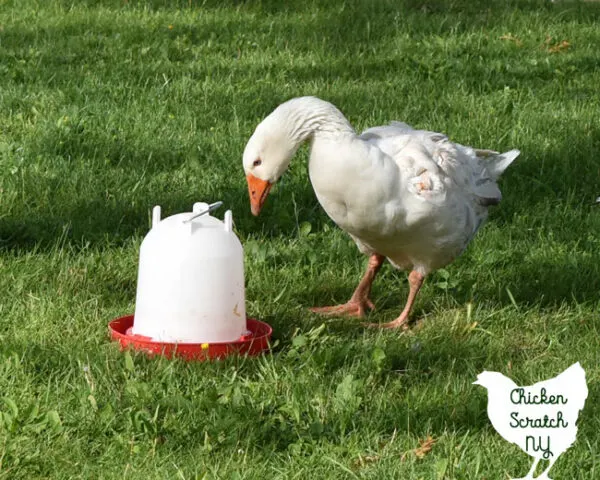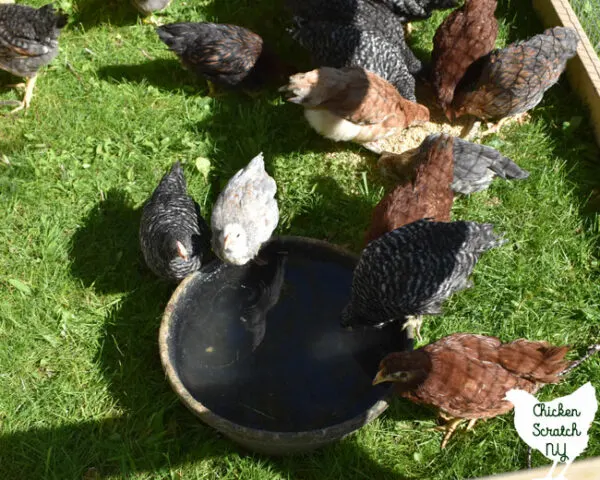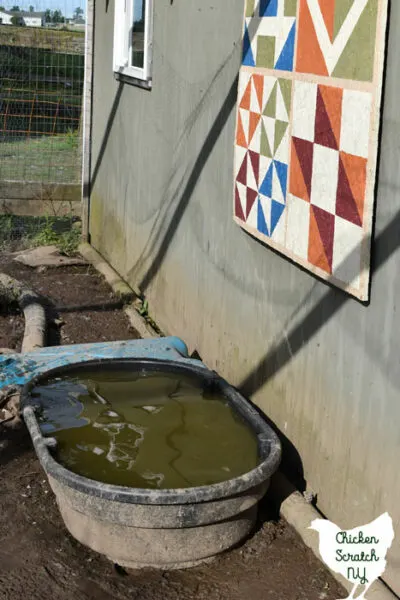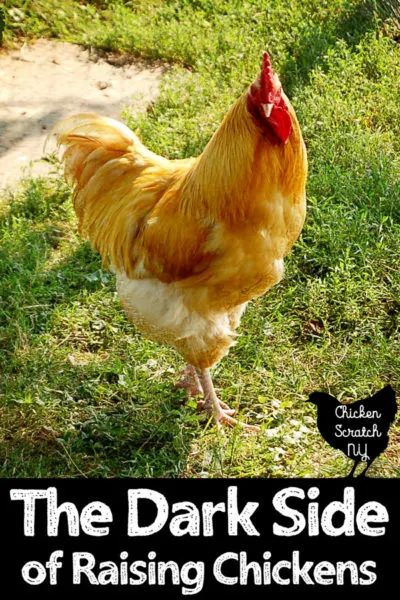Chickens should have constant access to fresh water, not only for their health and survival but also to keep them laying eggs. When it comes down to choosing a waterer you have several options and they all have benefits and disadvantages.

The topic of poultry waterers has been on my mind a lot lately, I was giving the latest round of chicks, poults, and ducklings water when I realized how much I hated the type of chicken waterers I was using.
Hating a waterer might not seem like a big deal but when you have to deal with them 2+ times a day for the rest of your life it’s really worth it to find something that works for you.
Over the years I’ve tried different things for water so today I wanted to break down a few different styles of waterer, what they’re good for, and where they fall short.
Disclaimer: I live in the North East and I swear it never stops raining so water isn’t hard to come by here. All of this advice is based on my personal experiences. If you live in the desert this might not work for you.
Flock Members
There are two groups of barnyard birds, the waterfowl, ducks & geese (maybe swans if you’re a special kind of crazy) and the land fowl, aka chickens, turkeys & guineas.
Right now I have chickens, turkeys, guineas, geese and ducks in my flock. They all require water, especially in the summer when the temperatures are out of control.
Read more about Raising Turkeys
The land birds are easy to please. Things get messy (so, so, so messy) when you add waterfowl, keep that in mind when planning your dream flock.
It might seem like the geese and ducks are splashing just to make a huge mess but they actually need to be able to dunk their faces and clear their nostrils in the water.
Plastic 2 Piece Chicken Waterer
Two piece gravity fed waterers are the standard choice for providing water to a backyard flock of chickens. I have a pile of them in slightly varying shapes.
Most two pice plastic waterers have a red base and an opaque white upper bucket but I’ve also seen them in white & green. You can also buy plastic lids that screw onto mason jars that work the same way.

To fill this style of waterer you flip it upside down, unscrew the red part, fill with water, screw the base on and flip it right side up. Sounds easy right?
Well, I hate them. I only use them in the brooders or my broody pens because they’re the right size and the shallow channels keep the chicks from climbing in and drowning or getting chilled.
Side note: You can add marbles or clean stones to the waterer base to help keep the chicks out. I never do it with chickens but it’s a good idea for guinea keets.
It is impossible to flip them without getting water all over. It’s not that big of deal out in the barn (let’s face it, water is way nicer than most of the things on that floor!) but on the porch it makes the concrete floor a bit hazardous.
And it really sucks when it happens in the kitchen or all over your clothing.
It can also tricky be to get the base on and off. The best way I’ve found is to wedge the bottom between my feet, line up the notched on the base with the divots on the top and give it a quick, sharp twist.
Over time the plastic gets brittle, especially if you’re using them outside in the cold or direct sun. I have a stack of bases left over from cracked tops.
That actually works out pretty well because the bottoms get nasty when the chicks kick the bedding all over. I switch out the bases when I refill them and can wash them at a later time which is great when I’m trying to get everything done before I go to work.
One more issue, with both the plastic and metal gravity waterers, if they’re not on flat ground they’ll leak all over. Sometimes it takes a while to find just the right spot on the ground to keep the water from running out all over.
I usually put my waterers up on 1×1 or 2x4s in the brooder to help keep bedding out but when you do that and the waterers get knocked off they’ll leak all over.
Read more about Setting Up a Brooder for Baby Chicks
Other Plastic Waterers
Along with the classic 2 piece twist waterers I’ve used slightly large plastic wateres with a built in heated base and a large plastic waterer with a screw off top.
I no longer use either and I don’t recommend them.
Heated Plastic Waterers
Keeping water available in the winter is one of the hardest things about keeping any type of livestock. I was hopeful that using heated waterers would be the solution to all of my problems.
Instead one of the bases on the heated waterer started melting and I was really lucky to avoid a fire. I immediately threw out both of the (expensive) waterers and never looked back.
Read more about the Challenges of Winter Chicken Keeping
Screw Top Plastic Waterer

The other plastic waterer I used was a plastic 5 gallon waterer with a removable top. It worked fine, did it’s job but after it died I didn’t replace it.
The main benefit is you don’t need to flip this waterer once it’s full, you take the little black cap and twist it on to cover the water spout at the bottom then uncrew the top and fill it up.
It’s also nice because 5 gallons is a good amount of water, especially if it’s really hot out and you are worried about your flock running out of water if you’re away at work for the day.
It has a deeper water dish and I found it was much more forgiving of the uneven ground than the metal waterers I use now. It’s much less likely to leak all the water out if it’s a tiny bit angled.
There are two things I didn’t like, one is that little black cap. I can’t tell you how many times I lost it. I’m not sure how but without moving more than 2 feet it was just gone.
The other problem I had was with the lid. You really need to lube up that seal or you’ll never get it open. If my ex-husband was helping me and he put that lid on? No way in hell I was going to open it and I’m not a particularly weak person.
2 Piece Metal Waterers
Despite the similar name metal two piece wateres are actually pretty differernt than the plastic two piece waterers. I prever them over the plastic ones for a few reasons.

It’s probably clear from the name but these waterers are also in two pieces. And, unlike the plastic kind, these waterers require no flipping!
You untwist the top and pull it off to fill, then place the top back on and twist to lock it on. There is a small pin on the base that fits into a groove on the top to hold it together.
There is a small rubber gasket on the inside that seals when the lid is off, in my experience you’ll still see a bit of leakage, especially as they age. If you’re having issues try running your finger around the seal to see if a leaf or anything is stuck and holding it open.

The upside to these waterers is they last for a long time and the big ones hold a lot of water. You can’t see how much water is in them but all it takes is a quick push with your hand or a foot to see how much water is left in them.
You can have problems with leaking if the black rubber seal inside doesn’t close completely or if they aren’t on flat ground. That part can be a bit tricky outside.
I try to avoid having water in the barn unless I can’t avoid it, like in winter when we have 4 feet of snow piled up around the barn. So I keep all of my waterers outside under the trees in the shade.
There is usually a bit of trial and error to find a good spot but once you have it accept the death of grass in that spot and keep the chicken waterer there forever. I’ve also had luck placing them up on bricks or inside a black rubber bowl.
Bowls
Speaking of bowls, I love using large rubber bowls for my flock. I use them for food, snacks, water and to hold leaky waterers.

With the exception of my gravity waterers in the brooders, this is all I use for water now.
I have about a dozen of them in rotation for various uses. They’re impossible to kill and not very expensive.
During the winter I keep two of these in the barn for water, I fill them up in the morning and again after work. There is another larger bucket for the alpacas that the geese and ducks can reach into.

Speaking of ducks & geese, they don’t need to have a pond or a pool but they do need to be able to dip their bills in the water and clean their nostrils.
They’ll splash and make a mess in the bowls but they also work really well for cleaning out the nostrils. All that splashing will deplete your water levels though and that’s why I use a lot of bowls.
Kiddie Pool or Tubs
You don’t need a pool or pond for ducks and geese but they’ll certainly enjoy having access to one.
I have a large kiddie pool and a new stock tank for swimming that double as an extra water source. If you’re familiar with keeping farm geese or ducks you know these are trashed pretty quickly.

This year I added a new tub to my chick brooder set up. Instead of my usual 3-foot tall stock tanks, I picked up a 50 gallon that’s only 12 inches tall.
After the ducks moved outside I moved the chicks into the larger tubs and moved the short one outside. I stuck in under the barn eaves and it filled up (it’s a 50 gallon capacity) in a few rainstorms.
I stuck a large rock in it to help the ducklings get out (and any chickens than decide to fall in) and it doubles as a water source and bath tub.
Always make sure your birds have a way out of the tub. One year I lost 6 Muscovy ducklings that climbed a fence post and went swimming and eventually drown because they couldn’t escape.
I’m not sure how they got into the tub but that day I learned an important lesson about being able to get out. Learn from my mistakes and remember there is a dark side to keeping chickens and all the other barnyard birds.
Nipple Waterers
This is my first year with a nipple waterer set up. I bought the chicken nipples from Amazon (I’ve waited my whole life to use the phrase “chicken nipples”) and followed the directions on the package to add them to a bucket.

I havn’t put that much effort into teaching my chickens to use them and they don’t seem that interested but it hasn’t stopped raining in 2 months so they have a puddle buffet.
Out of all the options this one requires the most set up, you can buy a bucket with the nipples already added but I’m pretty cheap and I own a drill so I bought the nipples and DIYed it.
If my chickens catch on I can see this replacing my metal waterers, especially if I can get a rain barrel set up with these at the bottom. I’ll still need to keep the kiddie pools or at least the rubber bowls in action to keep the duck noses clean.
What do you do for your flock? Is there another water option that I’m missing?
Don’t forget to PIN this to your chicken and livestock boards!
Check out my Livestock page for more info or start here:



